The Best Street Food in Southeast Asia | Local Dishes Recommended by Bloggers!
Some of the ultimate local and tastiest dishes are found in the best street food in Southeast Asia and I’ve put together a brilliant list for you to enjoy on your next trip around the region.
Following is the best local food in alphabetical order by countries around South East Asia including Cambodia, Indonesia, Laos, Malaysia, Philippines, Singapore, Thailand and Vietnam. All items on the list have been submitted by fellow travel and food bloggers about their best food experiences around Southeast Asia. I’ll warn you, you’ll be mouth-watering and wanderlust-ing reading this!
Disclosure: This blog post may contain affiliate links, meaning, at no extra cost to you, I may earn commission if you click through and make a purchase. As an Amazon Associate I earn from qualifying purchases. When you see a link or banner, this could take you to that product/service website. For more information, see my Privacy Policy and Terms & Conditions.
Contents – South East Asia Food
Contents (jump to)
To truly experience the food culture in Southeast Asia, street food is the best way to understand and will give you lasting memories about the delicious dishes that are on offer throughout the countries. For delicious food Southeast Asia has something for everyone regardless of taste, interest, dietary preference or allergy.
Map of Southeast Asia
Cambodia
Fish Amok
Submitted by Shireen, The Happy Days Travels
Starting off this South East Asia foods list we are taken to Cambodia. If there’s one dish that epitomises street food in Cambodia, it is Fish Amok. It’s the meal I instantly think of when I think back on my time on Koh Rong island and seaside place of Sihanoukville. These were the best spots to get Fish Amok because the fish was fresh from the ocean then steamed in a coconut curry sauce with steamed rice.
Beef Lok Lak
Submitted by Shireen, The Happy Days Travels
Beef Lok Lak is a Khmer meal consisting of peppery sauteed beef on a bed of lettuce and salad with lime juice and rice or rice noodles. This was my favourite street food in Cambodia and I even found some delicious versions in Melbourne restaurants.
I tried Lok Lak in both Siem Reap and Phnom Penh and enjoyed in both but Siem Reap topped it for me. In Phnom Penh, I am not 100% that it was Beef Lok Lak because the entire menu was in Khmer so we just guessed. It looked like Lok Lak and had similar ingredients but I do not know what the meat was. I was told later it was most likely Buffalo meat but Asian street food is that good that not much puts me off.
Indonesia
Gado Gado
Submitted by Haley, Haleyblackall
Originating in Jakarta, Indonesia, Gado Gado is one of the best street foods in Southeast Asia. The mixed vegetable salad with peanut sauce is a favourite amongst locals and tourists alike and can be found at any street vendor, depending on location, starting at as little as 12 000 IDR (£0.60). The earthy and citrusy concoction consists of fried tofu and tempeh, lightly blanched green beans, potatoes, bean sprouts, sliced hard-boiled egg, and a topping of garlicky peanut sauce and chopped peanuts. Of course, there are many variations of the popular Indonesian street food, such as the addition of cooked cabbage, rice, rice crackers, or chicken. But, the most popular way to serve Gado Gado is with light-as-air prawn crackers for scooping and a crunchy texture.
Gado Gado can be dated back to the 1600s with an original emphasis on using cashews rather than peanuts. Today, peanuts are more commonly used due to the price and availability of the nut. The dish can be eaten any time of day, for breakfast, lunch, or dinner, and is a staple in the Indonesian diet.
Klook.comGudeg
Submitted by Victoria, Guide Your Travel
Gudeg is a traditional Indonesian street food dish that is common in the area around Yogyakarta which is located in Central Java. It is traditionally made from jackfruit, specifically from young jackfruit. It is stewed in coconut milk and palm sugar for long periods of time until it is extremely soft and tender. A great variety of spices are added such a bay leaves, coriander seeds and teak leaves which gives gudeg a unique taste you won’t find anywhere else. It can be eaten for any meals during the day, even for breakfast. You can find a serving of gudeg from an Indonesia street food stall for prices as low as IDR30,000 (£1.50). Gudeg is commonly served with eggs, chicken and rice although other side dishes can be combined with it as well. Gudeg is known as a popular vegetarian food (if ordered without a side of chicken) and it can sometimes be slightly spicey although the spice won’t be overwhelming.
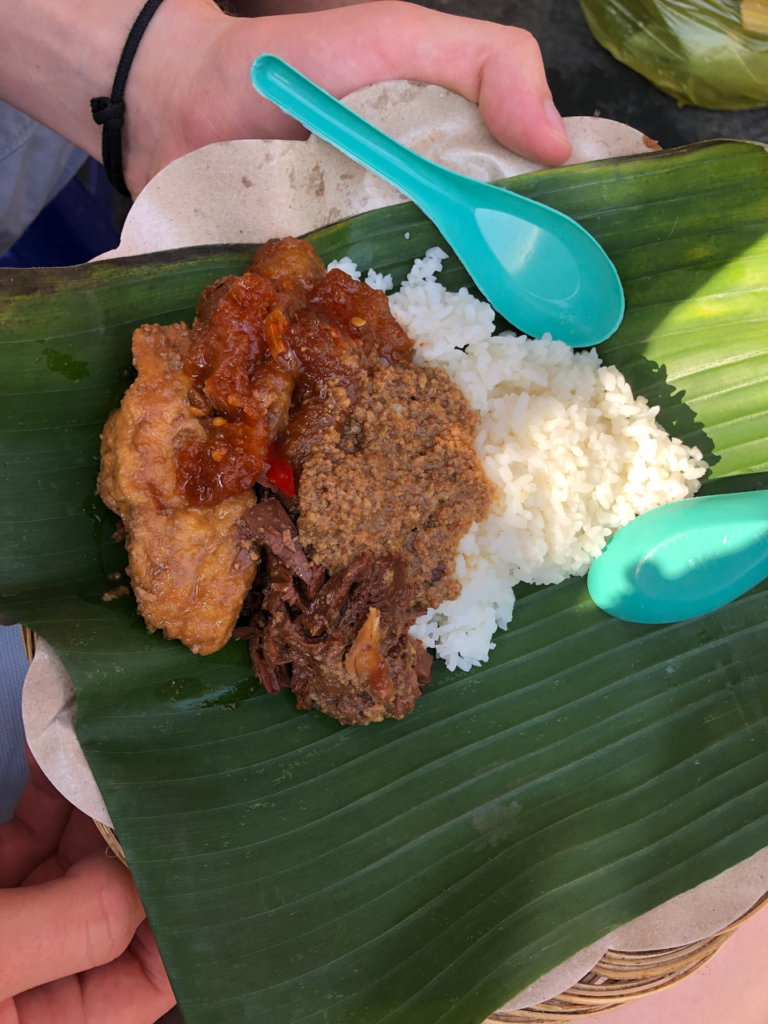
Nasi Campur
Submitted by Mal, Raw Mal Roams
Nasi Campur is one of the most popular street food in Indonesia that is eaten for breakfast, lunch or dinner. It translates as ‘mixed rice’, and it consists of a heap of rice served in the middle of the dish with a spoonful of various other dishes. Java has its own variety called nasi ramen, and the dish is also popular in Malaysia. Nasi Campur is typically served in local eaters called ‘warungs’ and in upmarket cafes in Bali where you can enjoy this traditional dish with a modern twist. The cost of the dish will depend on the place, but it starts from 20,000 IDR (£1).
The side dishes that accompany the rice vary from restaurant to restaurant and can include: stewed meat or fish that can come in a spicy sauce, fried corn fritters, sweet chilli flavoured tempeh, chilli boiled eggs, various vegetables that can come in a curry sauce. Nasi Campur is traditionally served in a buffet-style restaurant, where customers can choose the accompanying side dishes and a typically spicy sauce. The food is served on a bamboo-made plate with a banana leaf at the bottom.
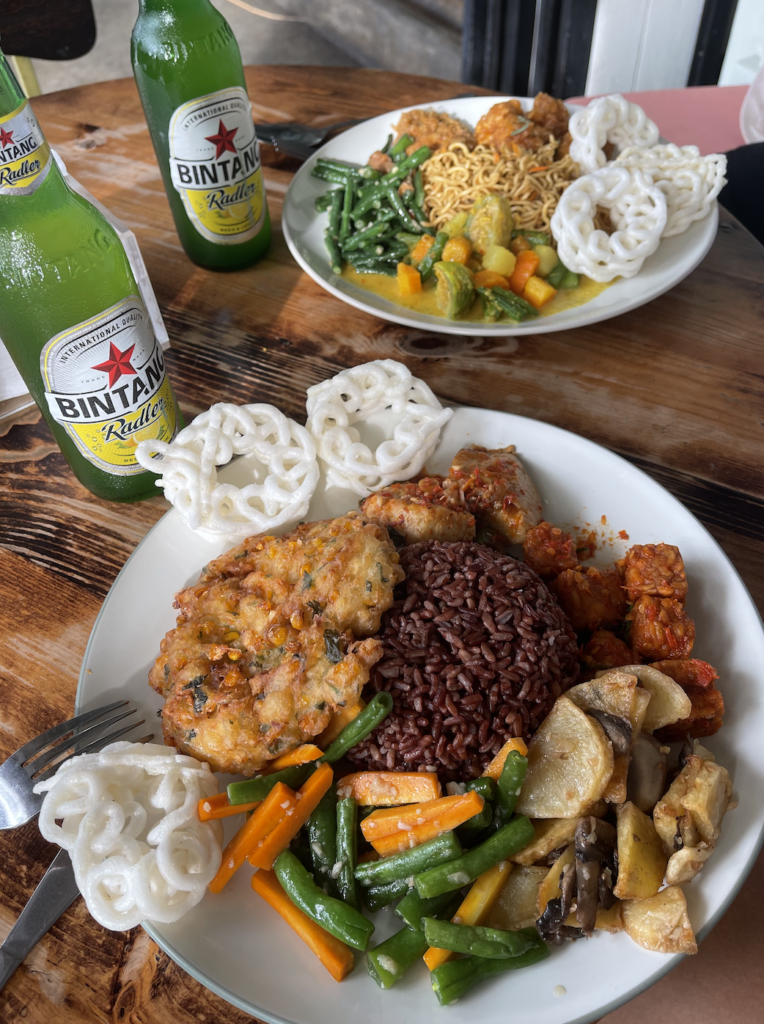
Read Next: 2 Day Safari Guide to Borneo!
Sate Lilit Ikan
Submitted by Larch, The Silver Nomad
One of the staples of Southeast Asia street food is sate (Indonesian spelling) or satay (Malaysian spelling). Diced or minced chicken, beef, pork or fish are threaded onto bamboo skewers and grilled over hot coals and served with peanut dipping sauce or a spicy sambal.
In Indonesia, sates tend to be chicken (sate ayam) but if you are in Bali, try one of their specialities, sate lilit ikan, a fish and seafood version. Fresh white fish and prawns are blended with freshly grated coconut, coconut cream, chilli, kaffir lime leaves, palm sugar, shallots, galangal (a root similar to ginger) and lemongrass. Instead of being threaded onto sticks, the paste is wrapped around bamboo sticks or lemongrass stalks and grilled over smoky coals. Sate lilit ikan gives you mouthfuls of slightly spicy, coconutty fish with a lovely smoky flavour. Perfect served with a traditional tomato and chilli sambal or with a lemongrass sambal matah. Costing around £2, for a handful of sticks, sate lilit ikan is served either as a side dish or a snack on the go, and a definite must-try for street food in Indonesia.
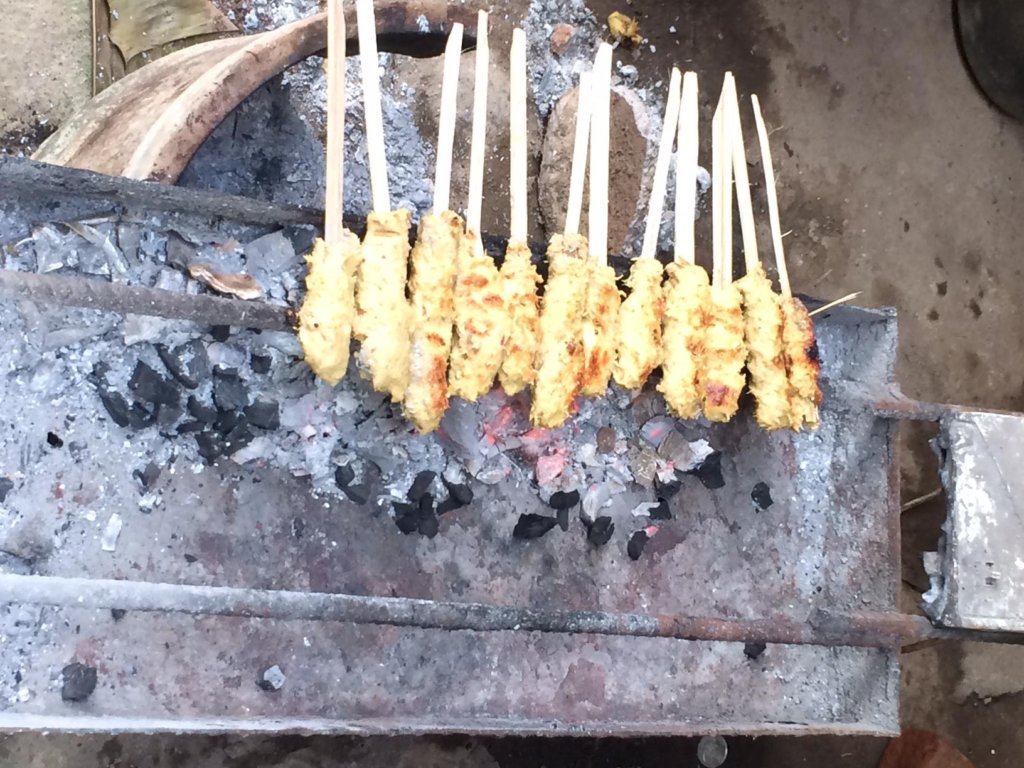
Why not take this an online Indonesian cooking class before your trip?
Laos
Khao Niew
Submitted by Marie, A Life Without Borders
Whilst the huge night buffet of Luang Prabang might draw the tourist crowds, a more popular traditional Laos food snack is khao niew. Found at markets and street side stalls right throughout Laos, these delectable sticky rice cakes are served on a bamboo skewer, making them perfect for eating on the go.
Made from patties of steamed sticky rice, khao niew are dipped in a spicy egg batter before being grilled over an open charcoal fire, giving it a distinctive smoky flavour. Freshly grilled on the spot until golden-brown, the Lao pancake snack is hot and crispy on the outside and soft and chewy in the centre. Often accompanied by fragrant paedek (fish sauce) or jeow bong, a spicy Lao dipping sauce, khao niew are usually eaten for breakfast or as a quick snack at any time of the day.
Costing a mere 5,000 LAK (£0.37), khao niew is a beloved Laos street food eaten with gusto during festivals and celebrations. Just a warning – these innocuous looking treats often have a mighty chilli kick to them!
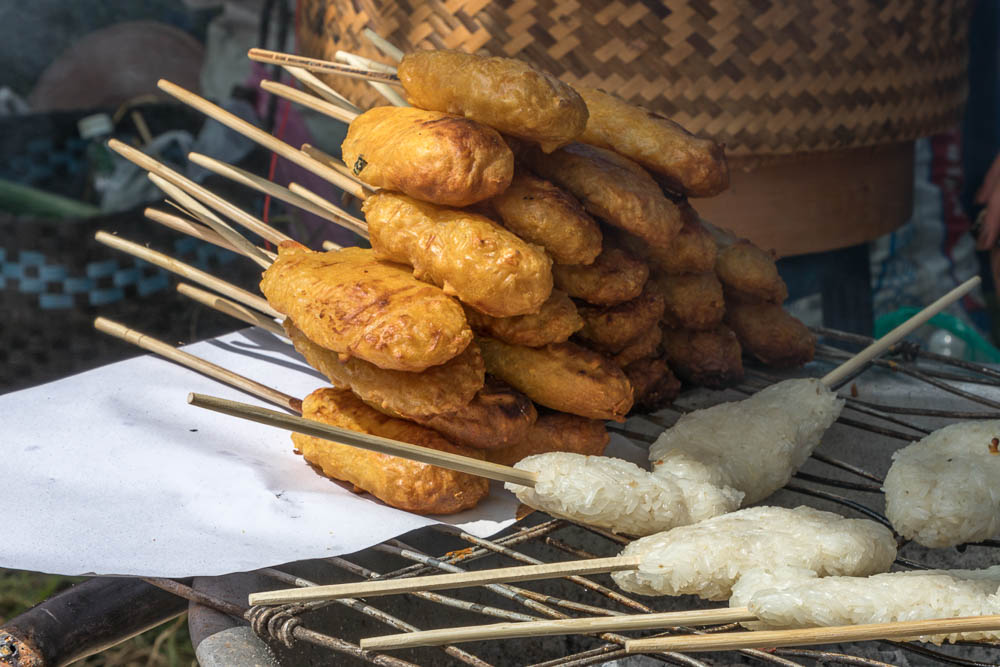
Khow Suey (Laos Khao Soi)
Submitted by Madhurima, Orange Wayfarer
The Laos style of ramen doused in flavourful broth is also known as Laos Khao Soi. The southern part of China, specially the Yuhhan region had witnessed a large number of migrant population moving towards the rolling hills of Northern Laos. Along came many cultural nuances which eventually blended well with Laotian lifestyle in nuanced emphasis. Laos Khao Soi is a perfect example of that. Khao Soi is a perfect meal if you are craving a hearty dinner and want to stay away from eating spicy meat platters.
The Laos style Khow Suey is served in a deep bowl filled to the bring with an intensely flavorful broth. Aromatic herbs grown in a typical Laos household’s kitchen garden goes straight in that bowl. Vegetables in raw and fermented state make their way in too. The watery soup is then further enhanced by the addition of Pork rinds and curdled blood. Fiery red chillies and seasoning are added to bring life to the soup. Fish sauce is added which often substantiates the use of salt. the vegetables were crunchy. The meat was subtle, rendered a smokey flavour since they were char grilled prior. The cooked rice noodles were flat, a bit on the heavier side and tasted perfect! You may choose to go vegan and refuse adding meat to your bowl of Khao Soi. The abundance of sprouted beans made up with their quirky taste! A bowl of Khao Soi will cost you around USD 2 (£1.50) in the Temple Town of Luang Prabang.
Malaysia
Curry Laksa
Submitted by Shireen, The Happy Days Travels
Also known as Assam Laksa or Curry Mee, this is a famous food in Southeast Asia and in the top 5 foods of the Lonely Planet’s Ultimate Eats list. There’s also a famous place in Penang that claims to serve the best Laksa in all of Malaysia called ‘Penang Road Famous Laksa’. Laksa is a spicy noodle broth in coconut milk, chilli relish and various meat/tofu toppings with greens and beansprouts on top. See more about Laksa under ‘Singapore’.
You May Like: A Day Trip to Penang Hill
Samosas / Curry Puffs
Submitted by Shireen, The Happy Days Travels
You can find samosas all over the world but when you try local samosas also known as curry puffs as a street food snack in Malaysia, you will crave them forever more (like I do)! I had delicious ones in both Kuala Lumpur and Penang but my favourite was from an unexpected place. There was a tiny laundrette next to the Friends Hostel in Kuala Lumpur which had a very humble, warm atmosphere. The samosas were made fresh each morning and sold from a plastic tuppaware outside the laundrette. Authentic and delicious.
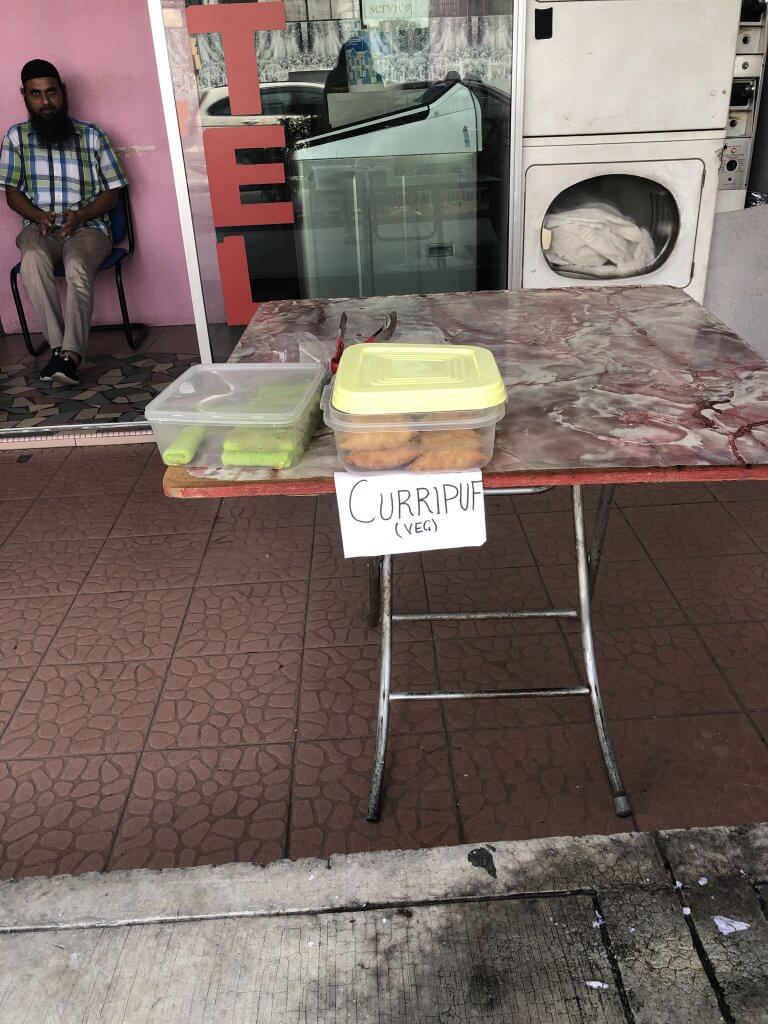
Wan Tan Mee
Submitted by Shireen, The Happy Days Travels
One of my most favourite foods in Southeast Asia is the delicious street Malaysian dish called Wan Tan Mee. You can have it stir fried and dry or in a soup and both are worth trying in Penang, Malaysia for the best specialities.
Wan Tan Mee is a noodle-based dish tossed in soy sauce with barbecued pork on top (the best slices of pork I’ve ever had) and includes meat dumplings. Wan Tan Mee is a great option for lunch.
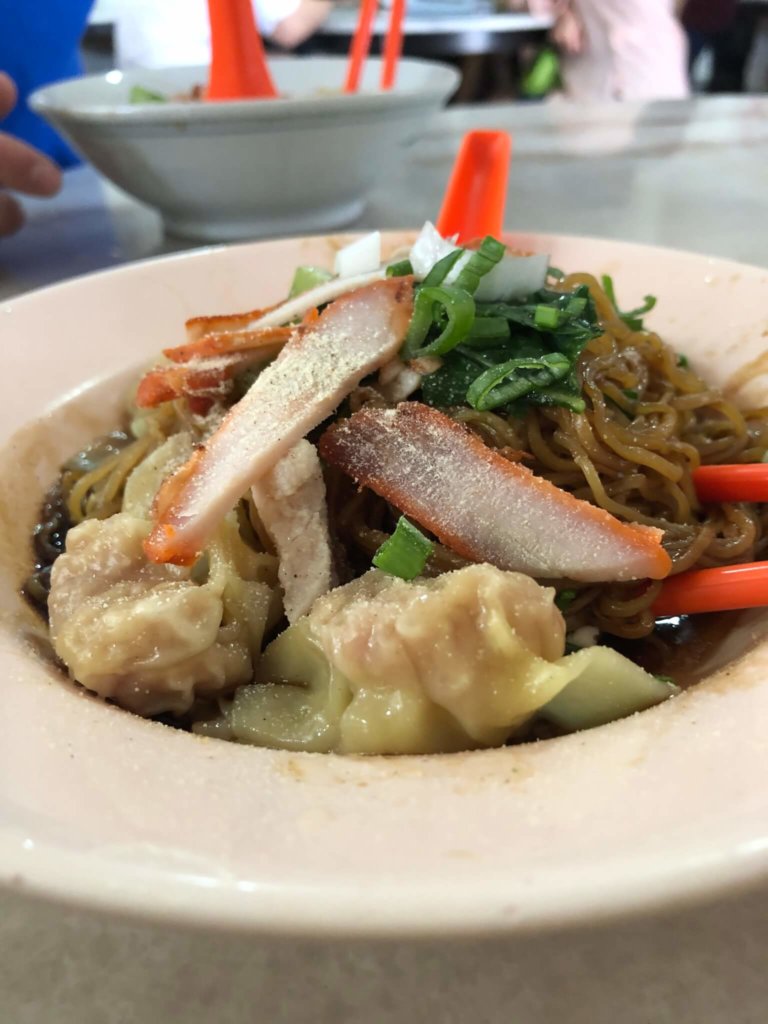
Read Next: Ultimate List of Street Food in Penang, Malaysia
Yong Tau Foo
Submitted by Iuliya, Vidadeliya
Yong tau foo can be literally translated to “stuffed bean curd” and is a Hakka Chinese food that you can easily find anywhere in West Malaysia particularly in Kuala Lumpur, the capital city of Malaysia. It is often accompanied by a clear broth, and can be eaten during lunch, dinner or even for supper by the roadside! It’s pretty common to have it as a snack too. When in doubt, just go for yong tau foo for street food in Malaysia!
Yong tau foo is essentially a dish that consists of fish and/or ground pork paste that is rolled inside tofu and bean curd skin. The beauty of this dish is that there are so many varieties of yong tau foo and some ingredients include bitter gourd, salted fish, shiitake mushrooms, okra, large chilli peppers and eggplants. Yong tau foo can also be cooked in many different ways including through deep-drying, steaming, pan frying or even boiling. Yong tau foo tends to cost around RM 1.50 (£0.30).
Phillippines
Lumpia
Submitted by Noel, This Hawaii Life
One of the most iconic street foods you will find in any outdoor markets, street side stands in the Philippines is the lumpia. The Filipino version of lumpia is a variety of sizes and preparations from more raw and vegetables with a sweet peanut sauce to deep fried roll with pork, meat or chicken with noodles and other veggies inside and served with a variety of dipping sauces.
Lumpia is a very popular street food that is also served as a side dish around the country. Typical sauces for this include a sweet and sour type sauce, vinegar, pepper and salt or plain old banana ketchup with can be bought in bottles. Lumpia is delicious fresh and hot deep fried in oil and ready to eat. You’ll enjoy walking around a market, outdoors and savoring some fresh lumpia as a snack or even a meal if you want added dishes to go with this. But lumpia basically is served as a side dish, snack or even dessert with wrapped sweet bananas, sugar and jackfruit that are fried with the basic wrappers to a yummy sweet snack. When you are visiting the Philippines, look out for lumpia fried goodness at a local market or street food stall.
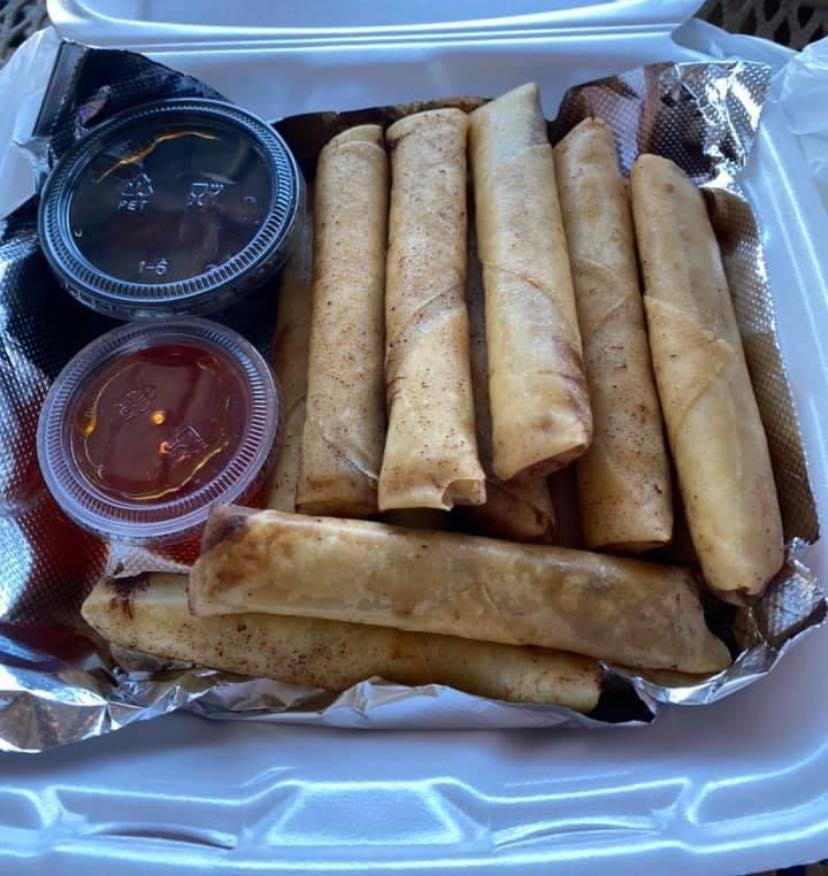
Why not try this beginners Manila food tour or this street food in Cebu tour to sample some Lumpia?
Taho
Submitted by Cecilia, Lovicarious
When in the Philippines, one is almost guaranteed to hear the sweet sound of “Tahoooooo!” emanating from the street at least once a day. Typically early in the morning, peddlers wander through neighbourhoods and city streets calling out the name of this Filipino comfort food. Vendors carry all of the equipment and ingredients over their shoulders in two large aluminum buckets suspended on either end of a pole.
When waved down by a customer, the vendor reaches into the larger bucket scooping out a portion of silken tofu into the cup. A thinner ladle is then used to scoop sago pearl (similar to tapioca pearls) from the second bucket then layering it into the plastic cup. The tofu and sago is then topped off with sweet arnibal, an amber-colored syrup made from caramelized brown sugar. Tahô can be found throughout the country with additional flavors such as chocolate and strawberry available in some regions.
At around 20 Philippine pesos (£1), Tahô is one of the cheapest and tastiest street foods you will find in the Philippines.
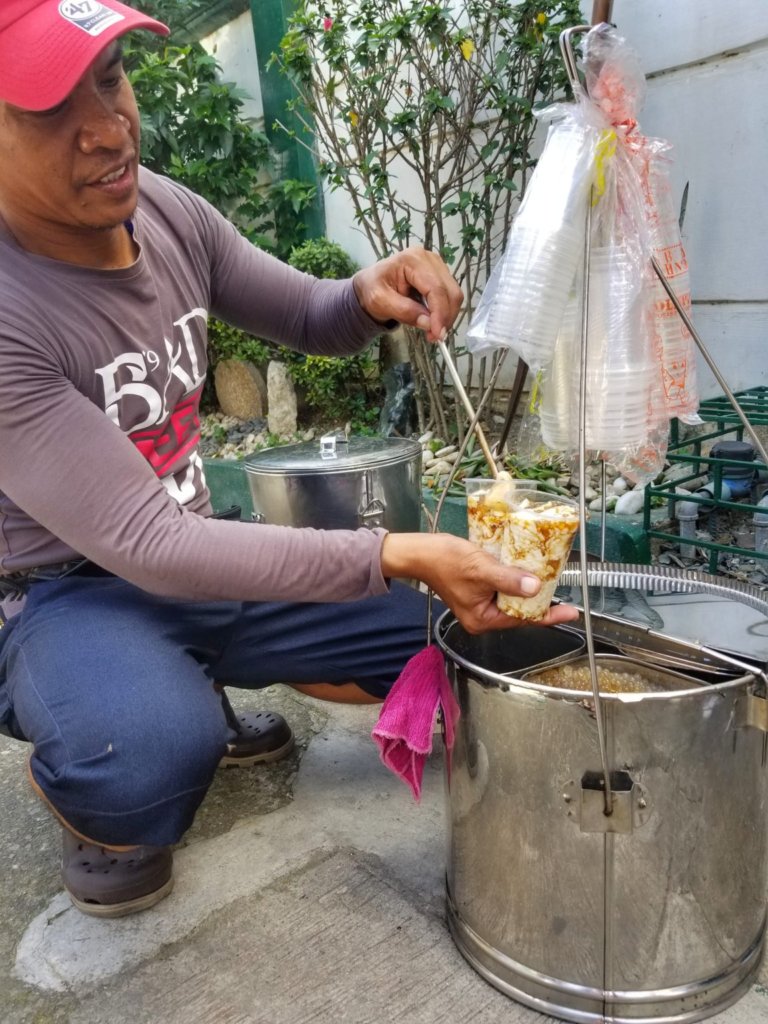
Turon
Submitted by Mikhaela, Youthsoloartsy
Most travelers tend to discover authentic and new delights for their afternoon snacks. No one could deny it. Nevertheless, you are staying at home. Here, now one of the all-time favorite and unique snacks in the Philippines is Turon. Learn more about these Filipino fried banana roll Turon. Turon is a fried banana roll wherein made of saba or Cardaba banana filled with brown sugar. It is best to partner with hot coffee or tea in the afternoon. You could buy this filipino street food near-stall located in every place around the Philippines. It began first in the local communities near banana trees and crop fields in the southern part of Luzon, Malabon. Price is 10php – 25pnp (£1).
The first variant of Turon is originated in Malabon, Philippines. The main ingredients are sweet mung beans, brown sugar, sliced bananas, and a spring roll wrapper. While the other one is turon with langka added for a sweet yet flavorful taste for your daily afternoon snack. Both are tasty and perfect for spending your time with meaning food tasting or satisfying your cravings while doing homework, break time, or a short trip along the road in a day. Other drinks suited for your food pairings with turon are smoothies and refreshing homemade juices. Many Filipinos choose to eat Turon to beat their hunger and intense hot weather during summer. This fried banana roll Turon is easy to prepare. In addition, you can get to taste the sugary yet delicious snack for you and the whole family.
Singapore
Laksa Soup
Submitted by Ingrid, IngridZenMoments
Laksa soup is a spicy soup popular in different countries in Southeastern Asia, particularly in Malaysia, Indonesia, Southern Thailand, and Singapore. However, you can find it at most Southeastern Asian restaurants in other places as well, such as Hong Kong or South Korea.
While you can have the tasty soup with different types of noodles or even chicken meat, the one you must particularly try is the shrimp laksa soup that comes served with a boiled egg, fried tofu, and beansprouts that will make it fresh. Don’t expect it to be as spicy as the Thai tom yum, however, there are plenty of strong flavours that blend to give this dish a special taste: ginger, coriander, lemongrass, and even garlic. The soup base is a bit thicker and has a lot of flavour from the coconut milk used for the curry and it’s perfect to be eaten on a hot summer lunch.
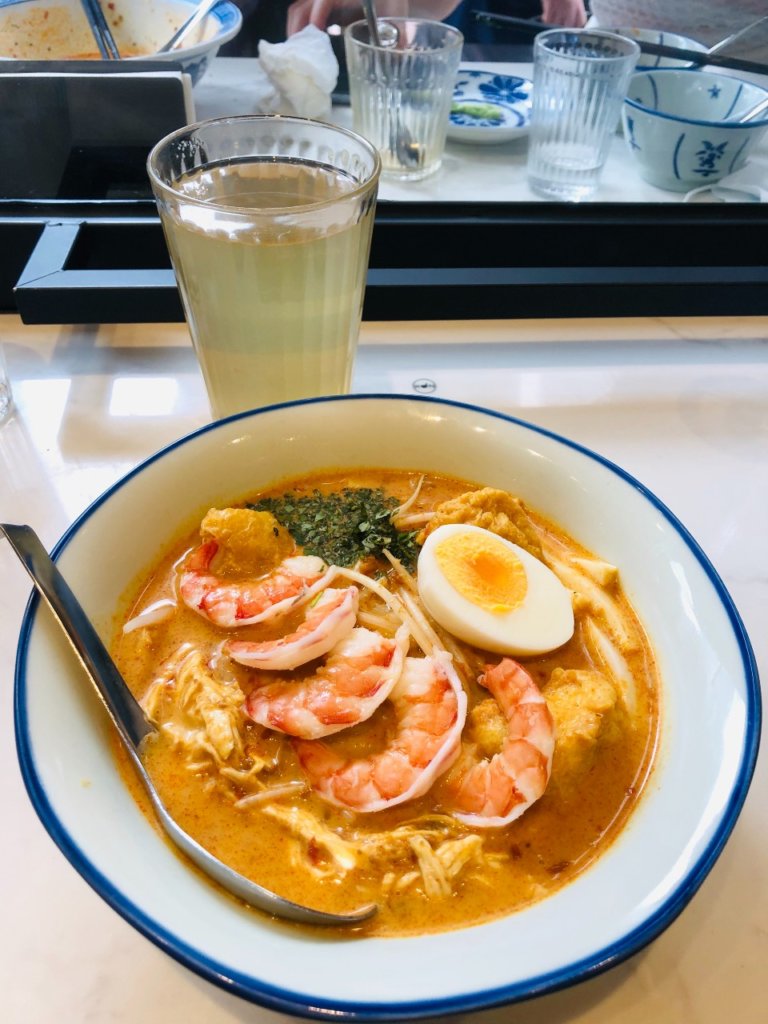
Roti
Submitted by Clara, Easy Chinese For Kids
Roti is one of the best Southeast Asia food. It is the most delicious circular flat bread you could ever eat. It is fluffy on the inside, with a crispy exterior. Available for breakfast, lunch, dinner, or as a snack in Singapore, Malaysia, Indonesia and Thailand. Common ingredients include flour, ghee, sugar, salt, and water. Plain rotis start from SGD $1 (£0.53) and are generally served with some curry sauce like dahl and sambal. You can also add fillings like egg, onion, cheese, butter, and sugar. Perfect for a snack. Buy a roti with kaya filling to make it great for breakfast. For a more hearty lunch or dinner, eat your roti with your favourite curry – chicken curry and massaman beef curry are popular choices. Have a dessert roti instead with lunch or dinner by choosing a sweet roti. Roti is a must eat food of Southeast Asia.
Thailand
Banana Roti
Submitted by Asha, Home Travel Guide
One of the best street foods that you have to try when you are in South East Asia has to be the Banana Roti in the streets of Thailand. Banana rotis are a bit similar to a crepe. The art of making one is pretty cool to watch; the skilled vendor stretches his dough into a paper thin sheet, he puts this into a big frying pan adding the banana and egg (some vendors offer different choices for the fillings). He then mixes this all together and skillfully folds the roti to form a square shape.
The roti is fried until golden brown and topped with a drizzle of condensed milk. It is served warm and cut into little pieces which makes it easier for you to eat using a stick.
Usually you eat these for dessert but they also make a great snack in between your sightseeing visits. For 60p you definitely have to give these a try.
Related Post: The Top Foods You Must Try in Chiang Mai, Thailand!
Chicken Satay
Submitted by Clotilde, A Princess Travelling with Twins
One of the tastiest dishes you will find in Thailand is Chicken Satay and a popular food in South Asia. A dish originally from Indonesia, it is now very popular throughout Southeast Asia. In Thailand, but also in Bali for example, it is found everywhere from the carts selling street food in tiny northern villages in Bangkok, to popular restaurants where it is a common dish. The chicken is cut into small pieces or strips, placed on skewers, cooked on the grill or over a fire, spiced and accompanied with a delicious peanut based sauce. A very simple recipe which can also be replicated at home, but full of flavour.
It is important to realise that chicken is only one of the possible variations of this recipe, it is equally common to find this Satay dish made with other types of meat or even fish. In Thailand, the use of pork is frequent, but this is avoided in the Muslim countries. Thailand is a country where you can eat at any time of day, so don’t be surprised to find chicken satay occasionally sold as street food even in the morning. At lunch or dinner it is often accompanied by sticky rice, practical to hold if you buy at the stalls. The price varies depending on whether you buy it from street stalls or in restaurants, starting from 50 baht and up. Whilst Chicken Satay is best enjoyed in the hubbub of Southeast Asia, you can easily try it in Thai restaurants across the globe, including London where you can explore the culinary delights of the whole world!
Book this online Thai cooking course or experience the street food tours in the Land of Smiles:
Klook.comKaprao Moo Grob (Stir-fried Crispy Pork Belly with Holy Basil)
Submitted by Allan, Live Less Ordinary
Thai food is fairly wide-ranging and diverse, and internationally it’s known for dishes that really are not very common. But in Bangkok, and all over Thailand, there are few Thai street food dishes as popular as ‘Pad Kaprao’ which translates as stir-fried holy basil. It’s kind of one of those quick lunchtime dishes easy to throw together on high heat and to rustle up for those in a hurry. The sauce brings together garlic, chillies, oyster sauce, soy sauce and, of course, ‘Kaprao’ holy basil which is stirred in at the end. There are many meat options as well for Pad Kaprao but it has to be best with ‘Moo Grob’ crispy pork belly, served on rice, topped with a crispy fried egg, and maybe some Prik Nam Pla sauce for added flavour. Kaprao Moo Grob is found at most street food areas and markets at the ‘ahan tam sai’ stalls (food to order) and it is hugely popular throughout Thailand and Bangkok. Typically a takeaway meal will cost between 35-45 baht. Order ‘Kap Bahn’ for takeaway and don’t forget the ‘chon’ spoon if eating on the move.
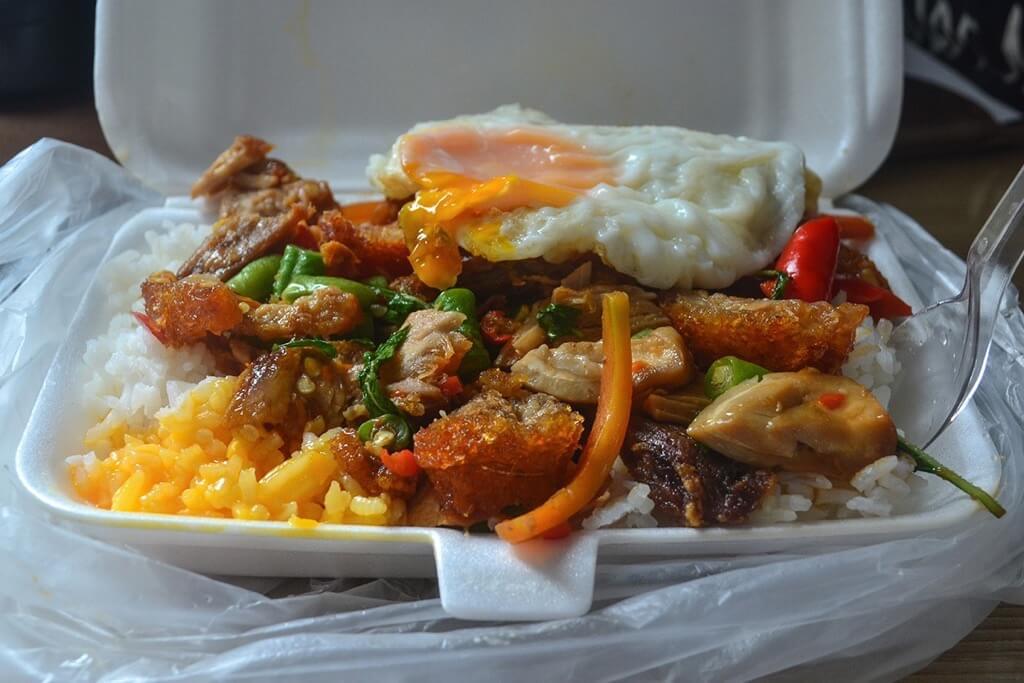
Khao Soi
Submitted by Shireen, The Happy Days Travels
Khao Soi is, in my opinion, the very best dish in Thailand and best food in Asia. I spent a month in Chiang Mai and had Khaoi Soi almost everyday from a Thai street food stall called Mama’s. Costing just £1 a bowl, this is enjoyed all times of the day but the earlier, the fresher. Coconut curry soup with egg noodles, veggies, meat and crispy noodles on top, this is one of the best foods in Thailand.
For underrated and lesser-known South East Asia food, Khao Soi is the perfect example and my absolute favourite Southeast Asia street food.
Related Post: Best 5 Places To Get Khao Soi in Chiang Mai
Malang Tod
Submitted by Rai, A Rai of Light
The streets of Thailand are brimming with some tasty and weird food to try. The most unusual of them all is Malang tod, or fried insects. This typical Thai food usually encompasses a good mix of a variety of insects that include beetles, crickets, grasshoppers, and bamboo worms. Other variations to try are spiders, waterbugs, and silkworms. Nothing is hidden as you get to see the insects being prepared, deep fried, and seasoned. This dish is accompanied with a fish and soy sauce and is generally consumed as an afternoon or late night snack. It is not only eaten for its unique taste and nutritious value, but also for its economic value at just 100 baht (£2) a serving. It may sound strange, but the insects are a very good source of both protein and iron. They are also a sustainable food choice. Malang Tod is readily available throughout the region, but the most famous and accessible option for a visitor is Khao San Road in Bangkok, where it is commonly sold by hawkers with food carts.

Massaman Curry
Submitted by Rachel, Mum With Wanderlust
Thai Massaman curry with its mild, sweet flavour is the perfect introduction to South East Asian curries for children and adults alike.
Massaman curry is usually made with chicken, beef or tofu, the thick sauce is flavoured with Thai red curry paste (red chilli, lemongrass, garlic, turmeric and shrimp paste) and it has a little Indian influence too with its inclusion of whole spices such as cumin, coriander and nutmeg. Massaman Curry is superb for your main meal in the evening.
Originating in Southern Thailand, near the Malaysian border, Massaman Curry is quite different to other Thai curries. Most Thai curries are more spicy but they rarely contain whole spices or whole peanuts* as the Massaman does. Massaman curry is usually served with rice but you could just as easily eat it alone as the curry also includes potatoes, another rarity among Thai curries. As with most Thai street food, Massaman curry is a great option if you’re on a low budget. In some places you will be able to buy this wholesome and filling evening meal for as little as 100THB (£2), but be prepared to pay much more if you’re choosing a fancy restaurant in a particularly touristy area.
*Note: A Massaman curry is not suitable for you if you have nut allergies – in fact a lot of Thai food contains nuts or nut oils – it’s always best to check before you order.
Pancakes
Submitted by Lisa, FlipFlopGlobetrotters.com
Vendors advertising pancakes can be found all around Thailand and tourists love this sweet snack. It’s one of Thailand’s favorite street food snacks. Actually, the name is a bit deceiving as it’s not really a pancake. There’s no batter that gets poured into a pan, but dough that’s stretched thinly and then fried on a hot plate. The Thai themselves call it roti instead of pancake.
Thai pancakes are generally not very healthy as the street vendors use cheap margarine and the cheapest vegetable oil there is, but they’re so tasty. You can get them with many fillings and toppings such as banana, Nutella, chocolate, honey or condensed milk. An all-time favourite is banana and chocolate.
Watching the vendors make the ‘pancake’ as you’re waiting for it is an attraction in itself, it’s truly a form of performance art. A small ball of dough is stretched thinly and fried on a hot plate, filling is placed in the middle and the sides are skillfully folded inward to create a square snack. You should eat this snack while it’s still hot and crispy, once it’s cooled it looses much of its deliciousness.
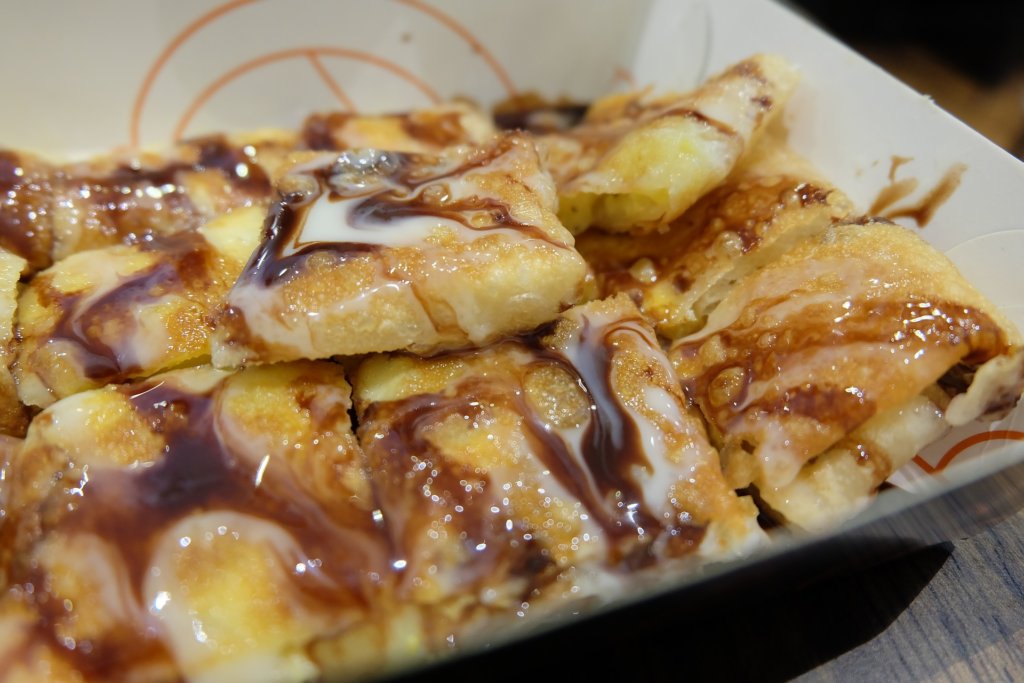
Pad Thai
Submitted by LeAnna, WanderInGermany
Thailand has so many reasons to love the country, but one of them is for all of the amazing street food it has to offer. For first timers in Thailand, the national Thai dish, Pad Thai, is an absolute winner. There is a reason why this dish is the most popular street food in Thailand, and that is because it is so delicious.
Every street vendor makes their Pad Thai a bit differently, and depending on the region of Thailand you are in, the recipes can vary as well, but no matter what, the outcome is still pure deliciousness. The rice noodle based dish is fried up in a wok right in front of your eyes and you can choose from meats such as chicken, shrimp, or tofu and you can even pick how spicy you want it, from not at all, all the way to blazing! The sauce can be made differently depending on where you are visiting. Some will use a tamarind base, others a straight up ketchup. It will all be fried up perfectly with some scrambled eggs, probably some shredded veggies like carrots, and a handful of peanuts are tossed on top to finish it. Squeeze a slice of lime over the whole thing and wash it down with a Thai Tea and you will be in food heaven! And if the taste alone isn’t one to make you a convert of Thai food, you just can’t beat the price. Depending on the location, you can get a giant to-go dish of Pad Thai for as low as 50 Baht (£1) on the street!
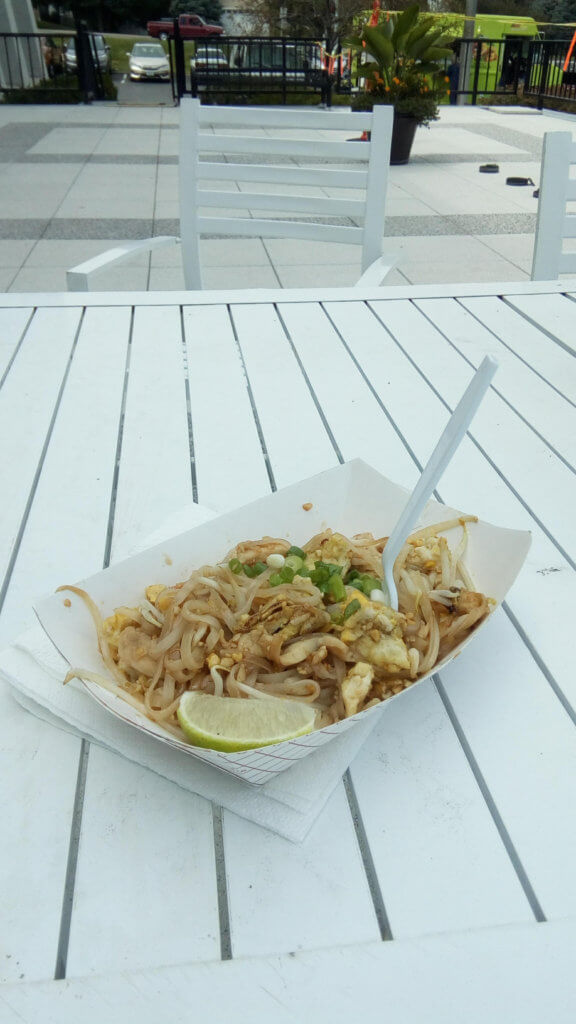
Sticky Rice and Mango
Submitted by Sylvie, Travels with Eden
Sticky rice and mango (also known as Khao Neow Ma Muang) is one of the most popular dishes in Thailand. It’s by far the best street food dish I’ve tried in Southeast Asia and one of the most common street food in Asia. The dish can also be found in other South East Asian destinations. The sweet and juicy mango taste goes perfectly with the sweet rice to make a fantastic summer dessert traditionally served on banana leaves and topped with sesame seeds. Sticky rice and mango are nicer and more widely available in April and May when mangoes are in season in Thailand. There’s also coconut milk and coconut cream in the dish for full flavour. All over Thailand, you’ll find sticky rice and mango at hawker markets and on street corners from Pai to Koh Samui. I was amazed when I first tried this dish in Bangkok but you’ll find sticky rice and mango everywhere in Chaing Mai, and I found it was the nicest there. The price varies throughout Thailand, but it’s not normally above £1.
Vietnam
Banh Mi
Submitted by Daniel and Ilona, Top Travel Sights
Banh Mi is amongst the best street food in Southeast Asia, and you can find it when travelling to Vietnam. The words Banh Mi translate to bread but usually refer to a delicious Vietnamese sandwich. The French introduced baguettes to Vietnam in the 19th century, and only a few decades later, they became a staple food all over the country. Bahn Mi itself likely comes from Saigon, where, in the 1950s, locals started eating this sandwich.
Traditionally, the filling consists of meat and vegetables. You might come across pork pate combined with another slice of meat as a typical filling, but some street food carts also let you choose your contents or prepare vegetarian sandwiches. For vegetables, most locals add pickled carrots and radishes, often together with fresh cucumber and, of course, coriander. Inside the crunchy baguette bread, the filling makes for a savoury, delicious street food dish that can easily replace a whole meal. It’s one of the most iconic Vietnamese dishes that you should definitely try on your next trip. When buying Banh Mi, you will usually pay between $0.50 and $2.00 (£1.50), with vegetarian options costing a bit less. Prices vary wildly throughout the country, so expect to pay more in big cities like Saigon and less in the countryside.
Hoi An is one of the best places to try Banh Mi and Vietnamese street food overall. I visited Banh Mi Queen and the same spots where Anthony Bourdain and Barack Obama shared a Banh Mi.
Bun Bo Hue
Submitted by Shireen, The Happy Days Travels
Vietnam really does have some of the best street food in Asia. Different parts of the country have their specialities too and in Central Vietnam (specifically Hue) is where you can find Bun Bo Hue. Enjoying local dishes in their native regions is a great way to learn the local culture of Southeast Asia.
Related Post: All The Foods I Tried in Vietnam!
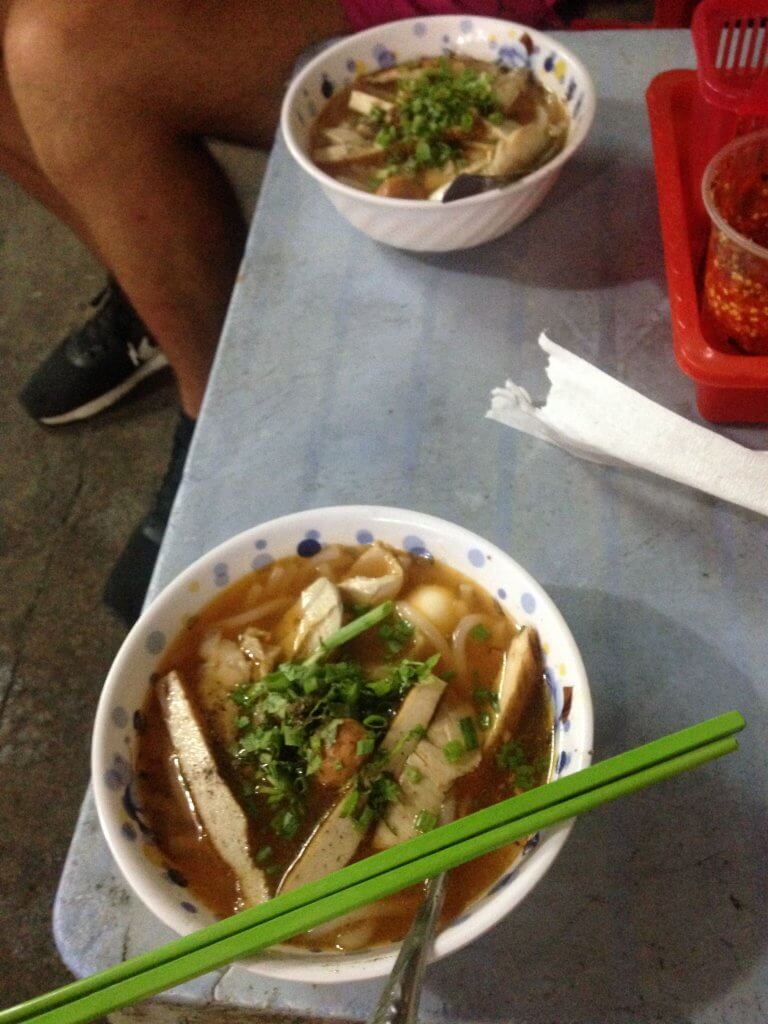
Bun Cha
Submitted by Trisha and Modi, TryWanderingMore
Bun Cha (pronounced “boon sha”) is a refreshing Vietnamese dish made of cold vermicelli style rice noodles (bun), grilled fatty pork patty (cha) served along with a broth of pork and fish sauce, a mountain of herbs and greens, a sweet chilli dipping sauce and sometimes even spring rolls. The meat and broth are served in one bowl, with all other accompaniments served in separate bowls. One can adjust the taste of the dish to their liking by adding chillies and garlic. Some eateries even serve a vegetarian version of the dish with or without Tofu.
Though found all over Vietnam, Bun Cha is the speciality of Hanoi- the capital of Vietnam. It is usually eaten as street food or at restaurants that focus entirely on bun cha. Depending on where you’re eating it, it costs about VND 35000 to VND 90000 (£3) for the entire set. On your Hanoi visit, you’ll find the aroma of grilled pork over charcoal wafting through the streets during lunchtime when the dish is exclusively eaten.
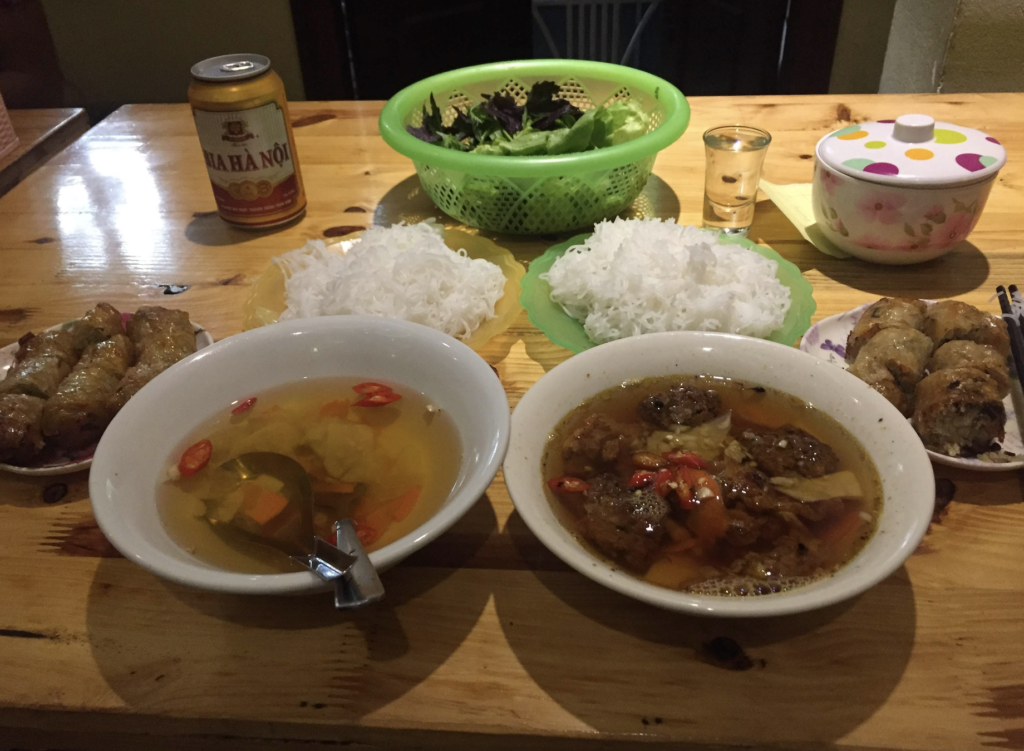
Pho
Submitted by Marco, Nomadic Fire
Vietnam has a fascinating history, a rich culture, and impressive natural beauty. But, the reality is that the country is best known for affordable low prices and delicious cheap eats. Vietnam’s street food scene is world renown, with travelers from all around the world, have been pouring into the country in droves to check out its amazing street food. While crab spring rolls and Bahn mi sandwiches are always on the menu, the number one favorite Vietnamese dish remains Pho. But what exactly is a pho?
First, know that contrary to when Westerners eat Pho, Vietnamese consider Pho breakfast food. It is a bone broth that street vendors simmer for 12 to 24 hours with a chef’s secret spice blend of fennel, anise, cinnamon, cloves, and onions. Charred ginger and roasted onions added, along with fish sauce and sugar to give the broth balanced flavours. There is no set recipe for the finished bowl of Pho because you get to customize your Pho to your liking. The basics are always the same; the broth is poured over Vietnamese rice noodles, along with thin slices of meat or seafood, vegetables, and fresh herbs. But you then add all the condiments and spice up or mellow out the flavors of the soup to your liking using a smorgasbord of different chili pastes, hot oils, and other sweet and savory sauces. A squeeze of fresh lime brings all the flavors together. Costing only 25000 to 35000 Vietnamese Dong (£1), for Pho-lovers, there is nothing better than sipping on a cheap piping hot bowl of Vietnam’s national dish.
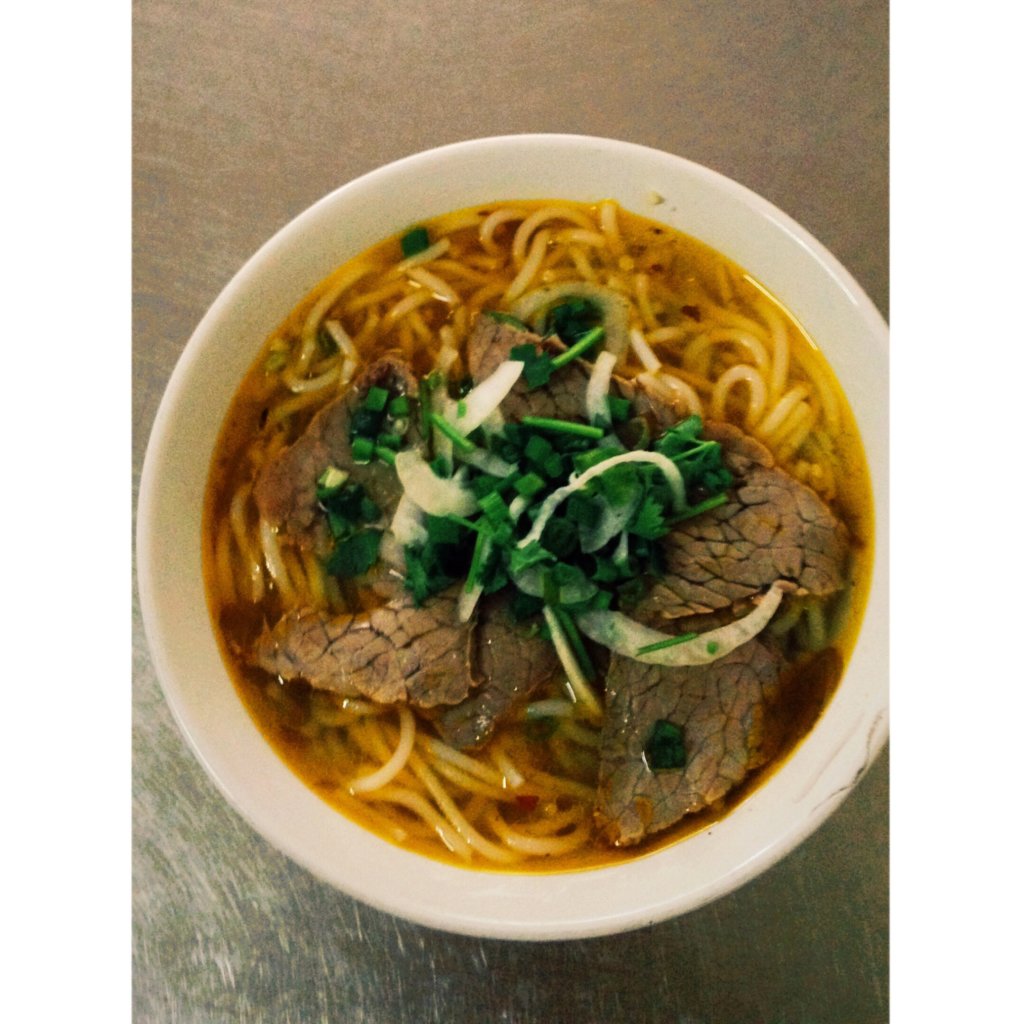
Spring Rolls
Submitted by Lavinia, Continent Hop
Vietnamese spring rolls are one of the most scrumptious and crunchiest snacks you’ll ever have to understand Southeast Asia food culture. Filo sheets are rolled and filled with a variety of ingredients ranging from vegetables to meat that has been seasoned and pre-cooked. It is then dunked in vats of oil and deep-fried till it is crispy. While it is usually had at meals, spring rolls can be had at any time of day.
If you’re visiting Vietnam, a plate when in Hanoi, usually costs as low as a pound or two for a plate of spring rolls, wherein you get at least 4 on a plate. Spring rolls are usually served with a peanut sauce and nuoc cham, a type of fish sauce for dipping. Sometimes rice paper is also used to make them and they could also be steamed. When steamed, they look transparent and the fillings can be clearly seen. Sometimes even noodles can be used as a filling!
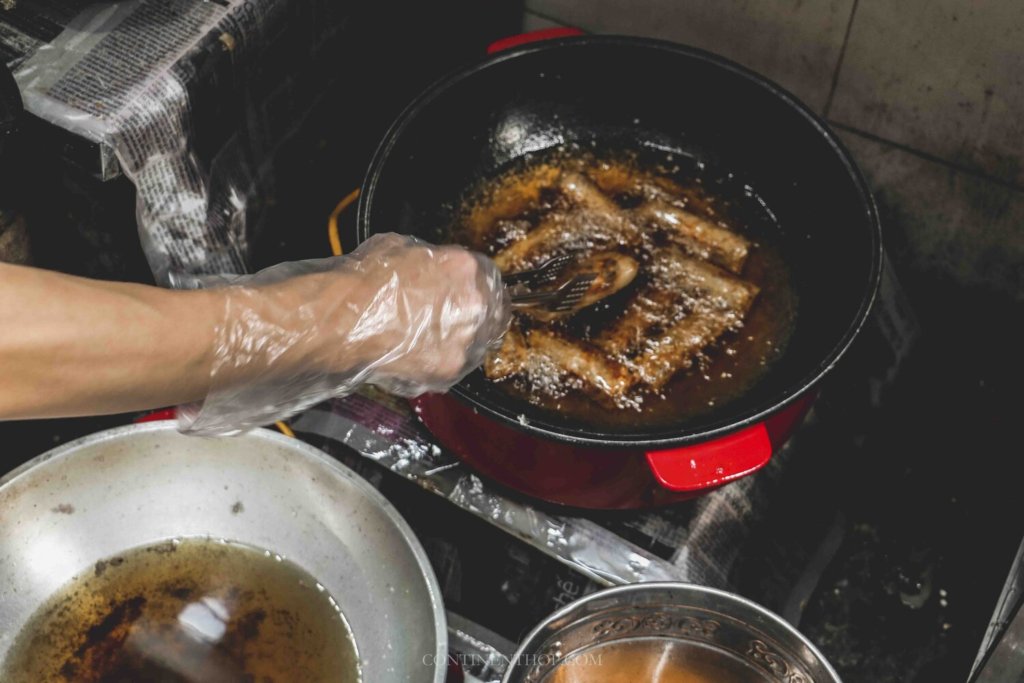
Thanks for reading this Food guide! Hope you have some ideas when you visit next or to try at home!
More Food Posts
- Street Food £30 Challenge in Depot, Cardiff, Wales
- Restaurant Guide to Melbourne, Australia
- Seafood Sundays in South Wales – A Journal
- Berlin Street Food Market, Germany
- Street Food £30 Challenge in Goodsheds, Barry, Wales
- Street Food $30 Challenge in Victoria Market, Melbourne, Australia
- Review of San Carlo, Bristol, England
- Best Cafes to Visit in Chiang Mai, Thailand
Like this Post? Please Pin It!
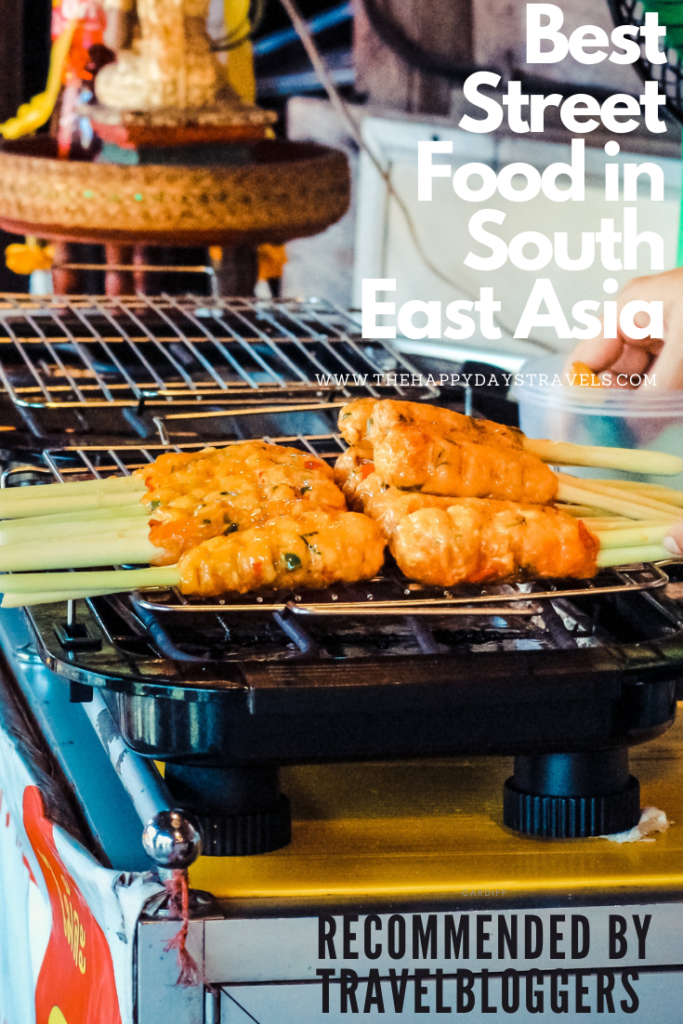


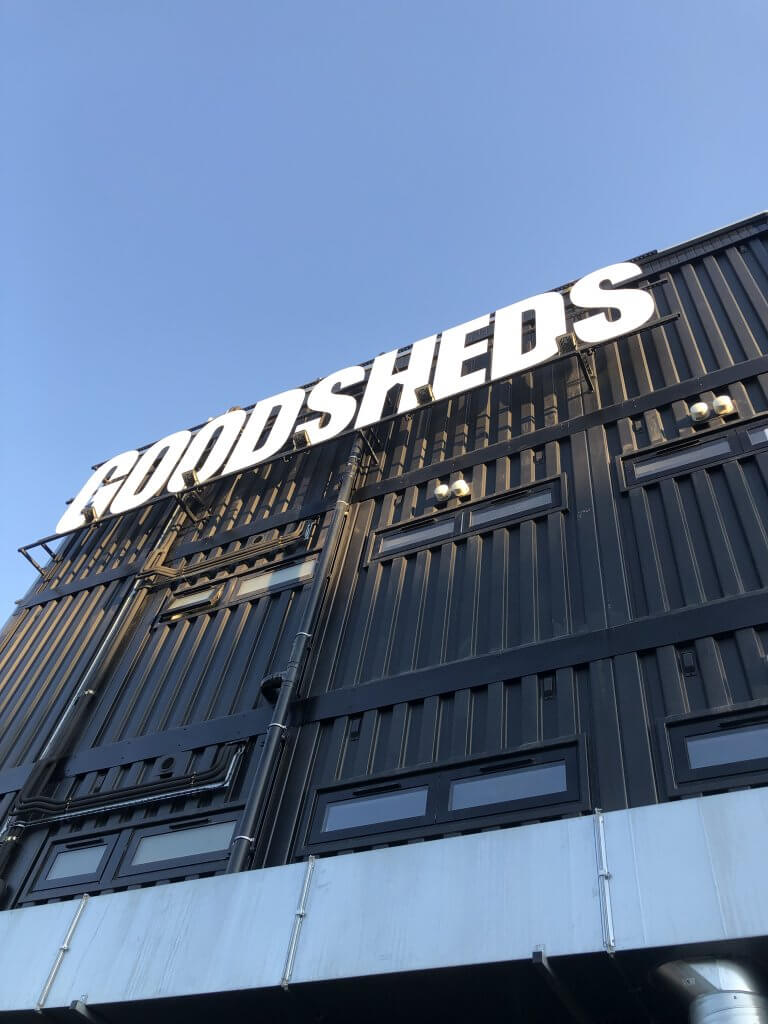
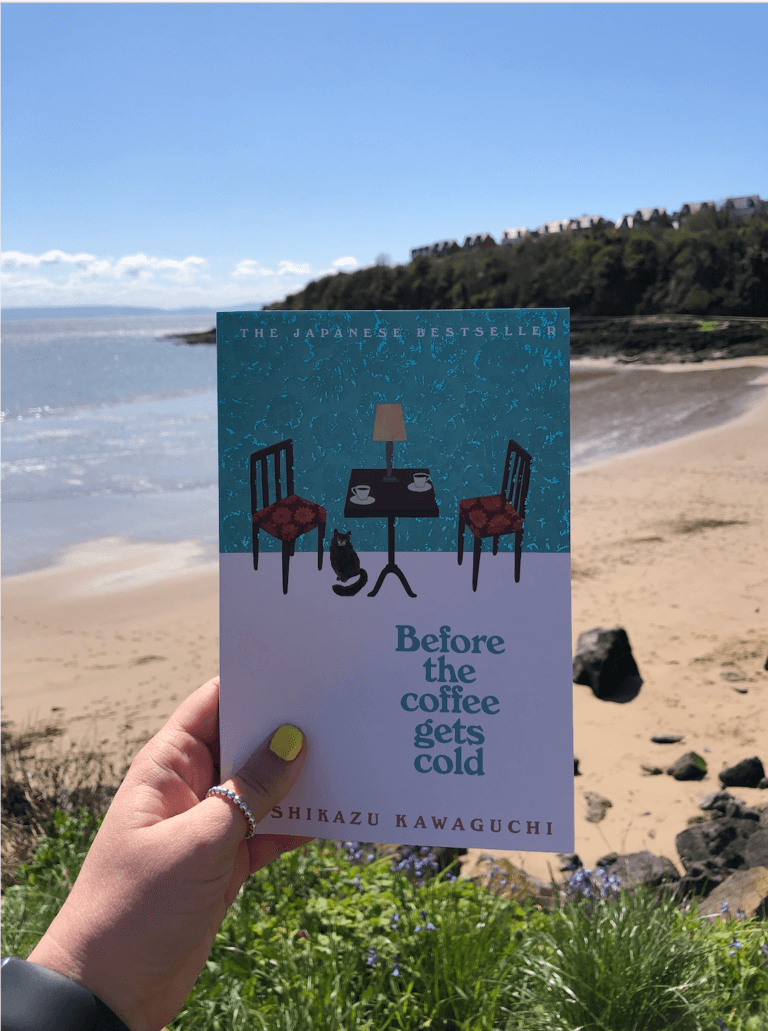


I love how many various best street food in Southeast Asia that we can try. It makes me think that it also improves your tastebuds in one plate eating, different authentic meals in a day. Thank you again for being part of your round blog post.
Thanks for your comment Mikhaela and for your contribution.
Thailand will forever be my street food paradise and everything was delicious!
YES! I’m with you on that one.
Street food is my favorite and wow do I miss the food of Thailand and Vietnam right now. I love mango sticky rice and bun cha, but I found a lot of new dishes here to drool over too
I loved this compilation of the varying foods, by different bloggers, of Southeast Asia! The food sounds and looks so amazing and I love how different bloggers tried different things. From street food items to restaurant items, it looks like Southeast Asia has a lot to offer!
This post is making me so hungry!!! Khao Soi is one of my favourite dishes too. I actually just found a place in Vancouver that makes it so hoping to order some this week. And my mom is bringing over banh mi on the weekend. YUM!
Riana I am so jealous right now!! I cannot find Khao Soi ANYWHERE where I live and it breaks my heart. I hope you and your mom have a delicious weekend!
I love trying new cuisines when travelling. It’s the best way to understand a culture. The challenge I have is being vegetarian, and making sure there are no animal or fish by products in your food is sometimes hard when there is a language barrier. Raman and curry dishes sound good to me.
That’s so true, Renee. Chiang Mai in Northern Thailand is a fantastic city for vegetarians, I had a few vegan Khao Soi while there and they were equally as delicious.
Really great food guide to the region with lots of details as to the ingredients. My favourites are Gado, gado which I tried in Jakarta and Bali( both slighly different in make-up).. I also tried lots of Pad Thai in Thailand and also here in the UK at my favourite Thai restaurant . Fried insects I saw but would never try, no matter how cheap they were or even if you paid me!.This article made me hungry from all those superb pics!
Oo I’ve never had Pad Thai in the UK! Is it authentic? What part of the UK are you living in Barry? Thanks for the comment.